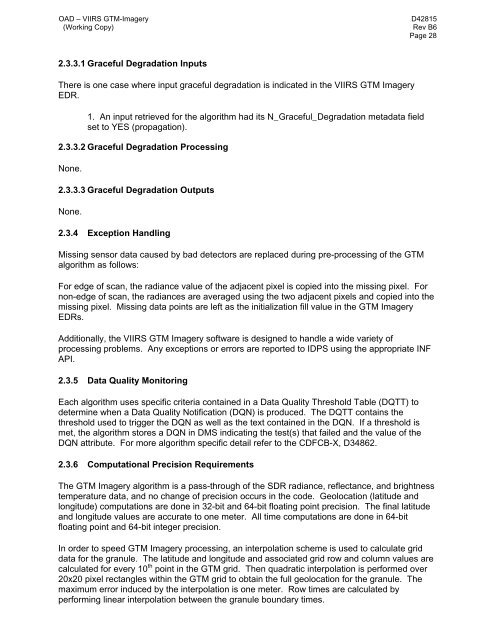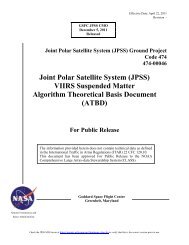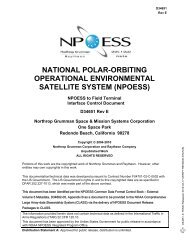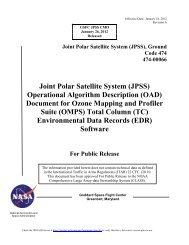(OAD) Document for VIIRS Ground Track Mercator (GTM) - NASA
(OAD) Document for VIIRS Ground Track Mercator (GTM) - NASA
(OAD) Document for VIIRS Ground Track Mercator (GTM) - NASA
You also want an ePaper? Increase the reach of your titles
YUMPU automatically turns print PDFs into web optimized ePapers that Google loves.
<strong>OAD</strong> – <strong>VIIRS</strong> <strong>GTM</strong>-Imagery D42815<br />
(Working Copy) Rev B6<br />
Page 28<br />
2.3.3.1 Graceful Degradation Inputs<br />
There is one case where input graceful degradation is indicated in the <strong>VIIRS</strong> <strong>GTM</strong> Imagery<br />
EDR.<br />
1. An input retrieved <strong>for</strong> the algorithm had its N_Graceful_Degradation metadata field<br />
set to YES (propagation).<br />
2.3.3.2 Graceful Degradation Processing<br />
None.<br />
2.3.3.3 Graceful Degradation Outputs<br />
None.<br />
2.3.4 Exception Handling<br />
Missing sensor data caused by bad detectors are replaced during pre-processing of the <strong>GTM</strong><br />
algorithm as follows:<br />
For edge of scan, the radiance value of the adjacent pixel is copied into the missing pixel. For<br />
non-edge of scan, the radiances are averaged using the two adjacent pixels and copied into the<br />
missing pixel. Missing data points are left as the initialization fill value in the <strong>GTM</strong> Imagery<br />
EDRs.<br />
Additionally, the <strong>VIIRS</strong> <strong>GTM</strong> Imagery software is designed to handle a wide variety of<br />
processing problems. Any exceptions or errors are reported to IDPS using the appropriate INF<br />
API.<br />
2.3.5 Data Quality Monitoring<br />
Each algorithm uses specific criteria contained in a Data Quality Threshold Table (DQTT) to<br />
determine when a Data Quality Notification (DQN) is produced. The DQTT contains the<br />
threshold used to trigger the DQN as well as the text contained in the DQN. If a threshold is<br />
met, the algorithm stores a DQN in DMS indicating the test(s) that failed and the value of the<br />
DQN attribute. For more algorithm specific detail refer to the CDFCB-X, D34862.<br />
2.3.6 Computational Precision Requirements<br />
The <strong>GTM</strong> Imagery algorithm is a pass-through of the SDR radiance, reflectance, and brightness<br />
temperature data, and no change of precision occurs in the code. Geolocation (latitude and<br />
longitude) computations are done in 32-bit and 64-bit floating point precision. The final latitude<br />
and longitude values are accurate to one meter. All time computations are done in 64-bit<br />
floating point and 64-bit integer precision.<br />
In order to speed <strong>GTM</strong> Imagery processing, an interpolation scheme is used to calculate grid<br />
data <strong>for</strong> the granule. The latitude and longitude and associated grid row and column values are<br />
calculated <strong>for</strong> every 10 th point in the <strong>GTM</strong> grid. Then quadratic interpolation is per<strong>for</strong>med over<br />
20x20 pixel rectangles within the <strong>GTM</strong> grid to obtain the full geolocation <strong>for</strong> the granule. The<br />
maximum error induced by the interpolation is one meter. Row times are calculated by<br />
per<strong>for</strong>ming linear interpolation between the granule boundary times.






